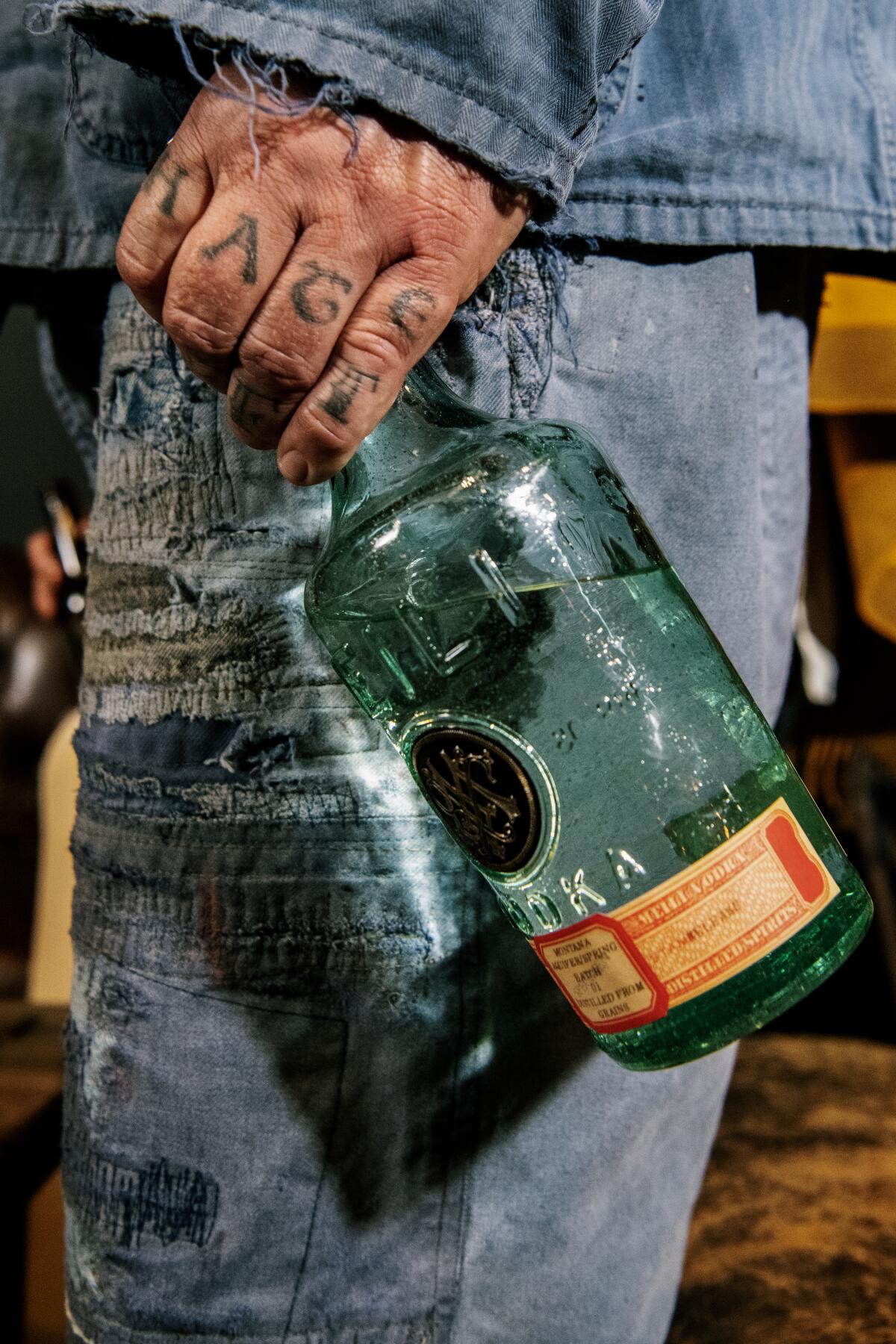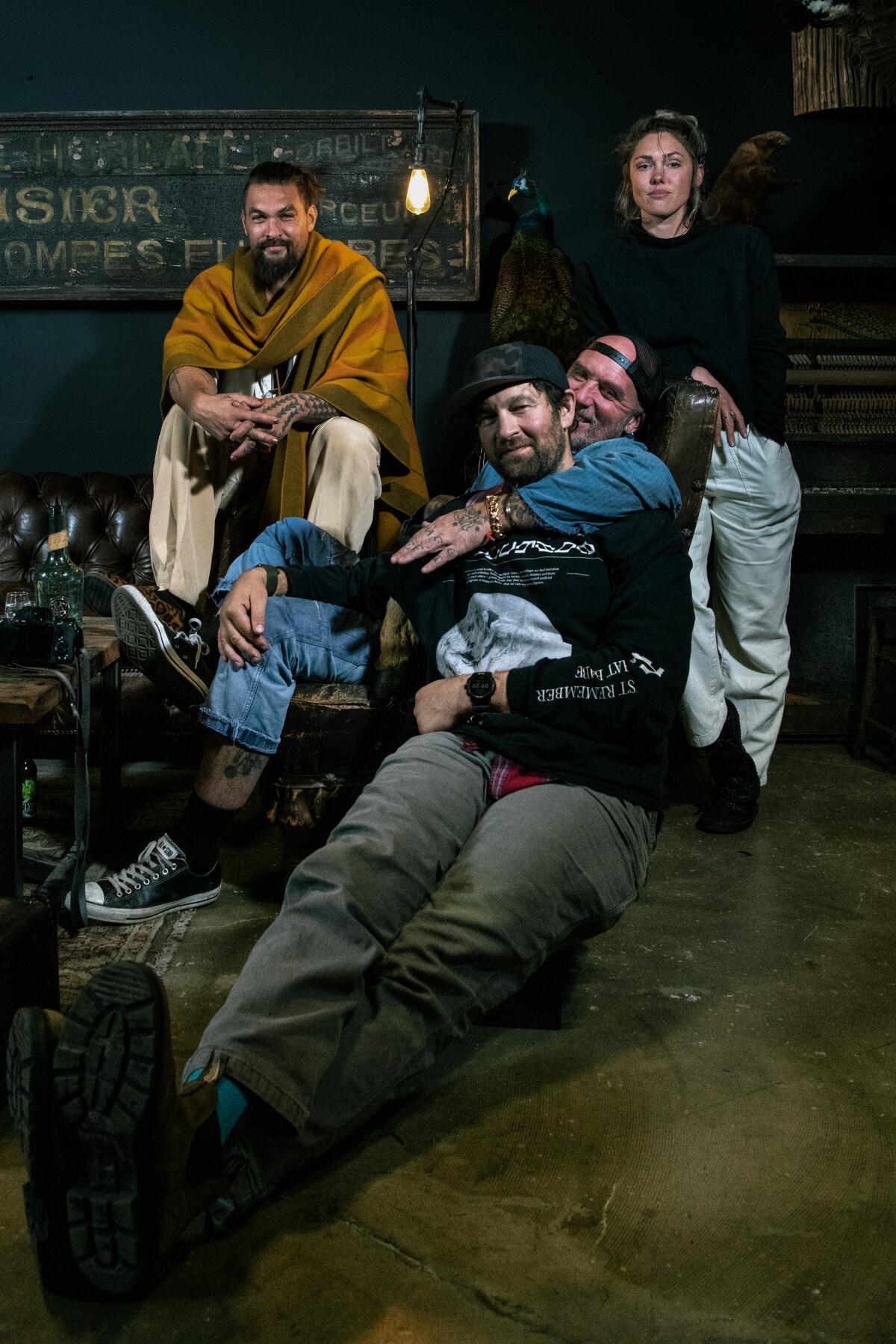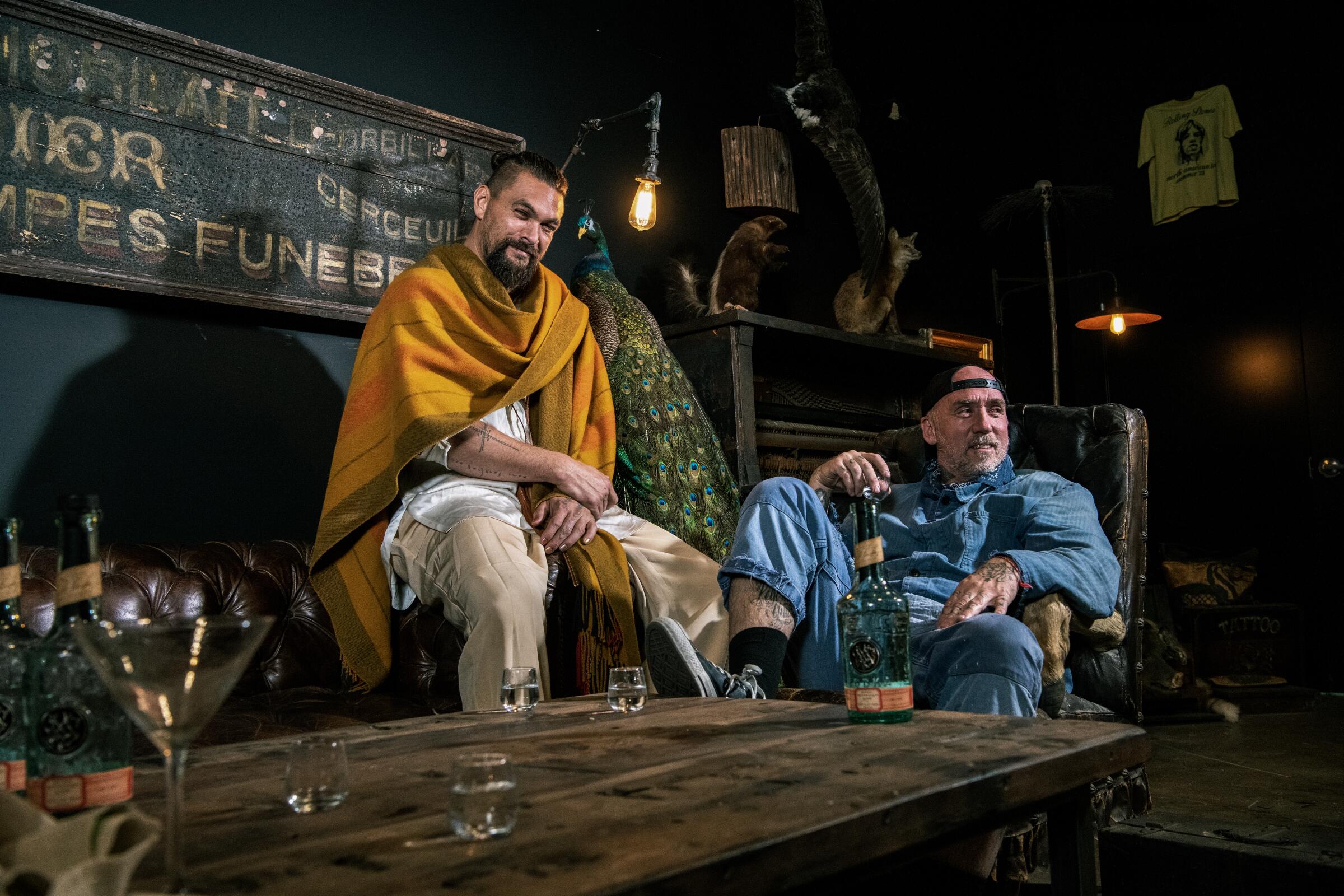Matt Brennan is a Los Angeles Times’ deputy editor for entertainment and arts. Born in the Boston area, educated at USC and an adoptive New Orleanian for nearly 10 years, he returned to Los Angeles in 2019 as the newsroom’s television editor. He previously served as TV editor at Paste Magazine, and his writing has also appeared in Indiewire, Slate, Deadspin and numerous other publications.
- Share via
1
Jason Momoa is not a vodka connoisseur. He doesn’t even particularly like the stuff — he’s more of a beer guy, if he’s being honest. Which admittedly makes it harder to wrap one’s head around the “Aquaman” star’s latest venture, after forays into climbing gear (So iLL x On the Roam) and bottled water (Mananalu).
Vodka.
Then again, to hear the catalog of inspirations for Meili, launched earlier this year with MadeWorn creator Blaine Halvorson, is to recognize that the vodka is not entirely the point. Pronounced “may-lee,” the project, as Momoa and Halvorson reveal over the course of a January evening in the latter’s Burbank warehouse, draws on the artistic kinship of Cy Twombly and Robert Rauschenberg, the rambling energies of the Beats, a pushpin map of Bob Dylan’s love songs; on polar plunges in the Montana wilderness, the Pontiac Ghost Car and the sweetness of wheat; on blue glass and compressed cork dust and yearning. Not the array of influences you expect to find for $24.99 in the liquor aisle at Ralphs.
Momoa, introduced to Halvorson by the actor’s then-partner, Lisa Bonet, immediately took to a pair of shoes the apparel whiz had cobbled out of an old doctor’s bag, establishing a shared affection for what Halvorson calls “these beautiful, tarnished things.” After collaborating on Momoa’s wardrobe for “Justice League,” “Aquaman” and “Frontier,” as well as partnerships with Carhartt and Harley-Davidson, that initial affinity became an enduring friendship, one defined by the commitment, almost transcendentalist in intensity, to “build,” as Emerson had it, their “own world.”
“I’m an early riser, and I’ll get up at 4 in the morning and I’ll have this amazing idea and I’ll call [Halvorson],” Momoa laughs. “I’ll be in the bathtub and I’ll be like, ‘I’ve cracked the code!’”
Seven years in the making, Meili — Old Norse for “the lovely one,” after the son of Odin — is the culmination of that commitment, unencumbered by corporate bureaucracy or studio interference: “This gave us the opportunity,” Halvorson says, “to actually do something that was ours.”
Which is not to say that Momoa, Halvorson and their other partners in the venture — filmmakers, spouses and climbing community friends Renan Ozturk and Taylor Freesolo Rees — are uninterested in turning a profit. Market forces, more than the spirit itself, led the founders — “Guinness all the way” Momoa and “big Italian reds” Halvorson — to choose vodka in the first place. “To us, vodka was broken,” Halvorson says. “We didn’t like the vodka that was out there. It was like rubbing alcohol. ... Literally, made only for mixing with something else.”
Still, for all the talk of taking on Tito’s, of securing shelf space in grocery stores and wooing bartenders at fashionable establishments like Chateau Marmont, it’s process, not profit margin, that seems to engage this small fraternity most. Some of the conversation, say of a plan to produce Meili in a defunct GM power plant in Michigan, is romantic to the point of absurdity; some, about the search for the right glass, the right stopper, the right water source, is granular in the extreme. All of it carries the enthusiasm — mostly infectious, maybe a little irrational — of a friend with a good buzz on. And the result, at least to the palate of this relative vodka rube, is the one they sought: a smooth, sweet, crystal-clear spirit that can be enjoyed neat, at room temperature.

“This isn’t a f— celebrity brand,” Halvorson says of Momoa’s involvement in Meili. “That has nothing to do with it. He just happens to be a celebrity.”
(Mariah Tauger / Los Angeles Times)
With vodka, as Halvorson is prone to saying, you can’t hide behind anything: “There’s no smoke and mirrors.”
When it comes to the smoke and mirrors of Hollywood, though, to the gloss — and press — that Momoa’s notoriety can bring to the brand, that’s a thornier subject. After all, joining the gold rush of famous figures to endorse, purchase or establish liquor companies since George Clooney turned Casamigos into a $1-billion mother lode in 2017 isn’t exactly a parable of rugged individualism or self-reliance.
“This isn’t a f— celebrity brand,” Halvorson retorts. “That has nothing to do with it. He just happens to be a celebrity. This is two people who really cared and built this. It wasn’t someone coming along and saying, ‘Hey, man, we made this thing, put your face on it.’ ... Every g— day somebody’s slapping a celebrity on something. They don’t know s— about it. They got no attachment to it.”
Momoa is more introspective, careful never to imply that his friends in the sector — Dwayne Johnson, with Teremana Tequila, and Ryan Reynolds, with Aviation Gin — are dilettantes. But in Meili’s case, he prefers “the juice to stand on its own.” Two days after launch, he hasn’t posted anything on social media about bottles on shelves. In seven years of work on the project, he hasn’t teased his involvement. “I don’t even think of myself as a celebrity,” he says. “It’s always very awkward to me. It’s very weird. If you knew me, you’re just like, ‘Oh, this is Momoa.’ I’m the exact same person I was before I got into this g— industry.”
In other words, he insists, celebrity is no more a part of Meili than it is of Jason Momoa.
“The world puts you in that position.”
And what a lucrative world it has become.
Though the love affair between Frank Sinatra and Jack Daniel’s dates back to perhaps 1949, and Sammy Hagar launched his Cabo Wabo house tequila in 1996, the celebrity booze boom arguably began in earnest with Sean Combs’ partnership with Cîroc in 2007 and reached maturity with Casamigos’ blockbuster sale to Diageo in 2017. Even beyond headline numbers that dwarf the most lucrative Hollywood paydays (see also: the $610-million price tag for Aviation), the financial logic doesn’t require an economics degree. The $37.6-billion-per-year spirits sector remains a major growth area in the alcoholic beverage business overall, according to the Distilled Spirits Council of the United States, an industry trade group: The sector has gained 13% market share since 2000, surpassing beer for the first time in 2022. And the reputational stink once associated with the celebrity “line” of products has diminished with their ubiquity, creating a win-win — or at least no-lose-no-lose — situation for boldfaced names in search of a foothold.
Still, it can feel as though the trend has entered its rococo stage, with the ever-proliferating list of star/brand relationships reading like a gag out of “BoJack Horseman”: Jay-Z’s cognac, Scottie Pippen’s bourbon, Vera Wang’s vodka, Cheech Marin’s mezcal, Dita Von Teese’s gin, Bruno Mars’ Panama rum, Rita Ora’s tequila, GWAR’s limited-run rye. The trend has even spawned a backlash of sorts, with Siempre Tequila employing the tagline “Celebrity Not Required.” If, as the New York Times’ Amanda Hess argues, we live in the “golden age of celebrity branding,” liquor is the filigree on its balustrades, the inlay on its armoires, the leaf on its chandeliers.

Clockwise from left, Meili’s Jason Momoa, Taylor Freesolo Rees, Blaine Halvorson and Renan Ozturk.
(Mariah Tauger / Los Angeles Times)
It’s easy enough to dismiss these partnerships as yet another cash grab in an industry, an economy, a society full of them; just add a stop for “liquor brand” between “Super Bowl ad” and “ghostwritten memoir” to the modern celebrity’s Stations of the Cross. To hear Momoa and company tell it, though, the motivation for a project like Meili isn’t always so simple — and among the range of relationships that fall under the “liquor brand” umbrella, from endorsement deals to co-ownership stakes to something like actual craftsmanship, there is space for ambitions more philosophical than pecuniary.
As Momoa says, he still has to sleep at night. “I get offered so many liquor brands. I get offered so many water brands. Anything. ‘Would you be the face of this?’
“I act and someone goes and edits it, and either it’ll be good or it won’t be,” he continues. “What I love doing is directing and writing and doing it on my own. ... If you’re going to judge me and hate my form, it’s like, ‘I’m responsible for this. I chose this direction. Now pick on me.’”
In the entertainment business, where the line between feedback and meddling blurs easily and turf battles are as common as collaboration, Momoa’s thirst to be master of his own fate is understandable. And although it’s inextricable from wealth, the power to achieve such freedom is not exactly coterminous with one’s net worth — a force that explains the extent of the celebrity endorsement industrial complex more satisfactorily than money alone.
It’s a sentiment echoed by Halvorson, who counts “never having to work for somebody” among his many blessings, and Ozturk, whose relationship to the industry’s corporate superstructure might come closest to that of the Hollywood rank-and-file.
“I think all of us have spent a lot of time in all of these combined industries and realized life is short and you want to work with people who aren’t a— and you want to have fun,” Ozturk says. “We also do a lot of crazy commercial work. [Momoa] does it, but it’s more on his own terms than we do. Those commercial jobs, there’s 100 people standing around looking at everything you’re shooting on a live feed and telling you what to do.”
Meili, he adds, “does seem like a way out of that perpetual commercial cycle for all of us.”
Within the highly specialized sector of the economy we call “celebrity,” in other words, every Emmy winner and platinum artist might be much the same as you or I: fantasizing about the opportunity that will finally free us to be who we want, to do what we want, to afford to answer to nobody but ourselves. This is also, of course, the logic of capitalism at its most perverse, a way of jumbling Emerson’s directive to build our own worlds with society’s directive to build our own wealth. To survey this particular “golden age” of shapewear and cosmetics and coffee and throw pillows and, yes, the world’s smoothest vodka is to surmise that even the most well-off among us are eager to escape the system’s ceaseless rigors, and have decided in turn that the only way out is through.
Then again, it’s possible I am reaching for something that isn’t there. Maybe I’ve been blinded by my own yearning for the world of celebrity in which I immerse myself 12 hours a day to add up to something more than box office receipts and shiny gold statuettes and outperforming the competition in the demo. Perhaps I am guilty, as Halvorson describes the process by which he and Momoa gathered Meili’s influences into a $20,000 coffee table book with a print run of two, of “pareidolia,” which Merriam-Webster defines as the tendency to perceive a meaningful image in a random pattern.
In any case, it’s getting late, and we have had our fill of vodka, and Momoa, still in his wardrobe from “Fast X” reshoots this morning, has another 5:30 a.m. call time. Reality beckons.
Even in the town that factory-produces the fantasy, it always does.









